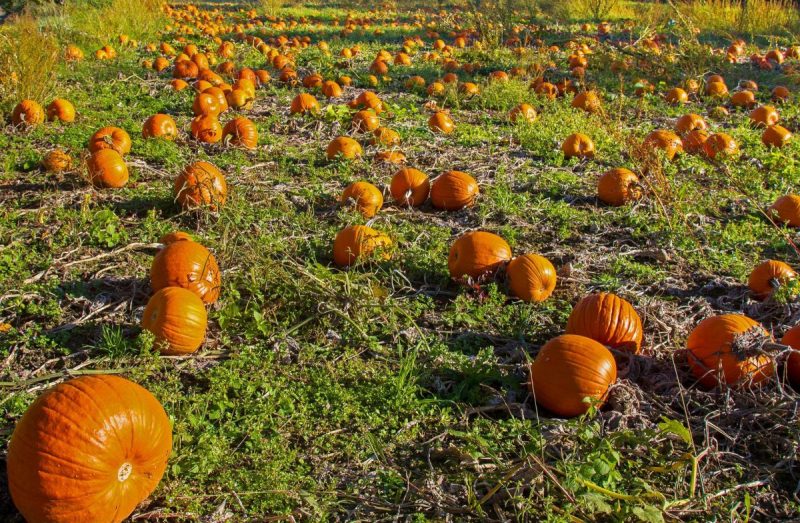Pumpkin, treatments against pests and diseases

Pumpkin (Cucurbita maxima) is an annual herbaceous plant, cultivated for its fruit, flowers, and seeds. It is an annual plant, with a flexible and hanging stem, with cordiform (heart-shaped) leaves, large in size, and well-marked veins. The pumpkin flowers are yellow and fleshy, and the fruit can be long or spherical, gray or orange. The pulp of the fruit is yellow-orange, dense, with a sweet taste. The pumpkin contains numerous oval, convex, and smooth seeds, 2-3 cm long, which contain a white and edible core. The pumpkin crop can be affected by pests and diseases, against which it’s important to apply the right treatments.
The main diseases of pumpkin
Mycosis
Cucurbits downy mildew (Pseudoperonospora cubensis)
Pumpkin plants are attacked in all phases of vegetation, on the leaves showing as numerous spots, usually colorful, at first greenish-yellow and after a few days dark brown. Next to the spots, on the lower face, a greyish-purple fuzz forms, consisting of the mushroom’s fruiting bodies. The attack is very rare on the fruits, they remain small, do not reach maturity, and have a faded taste.
Prevention and control measures:
- growing healthy seedlings and seeds;
- avoiding planting too close together;
- chemical pumpkin treatments with specific fungicides.
Cucurbits powdery mildew (Sphaerotheca fuliginea)
The disease is manifested on both sides of the pumpkin leaves, in the form of a white, powdery growth, which can cover the entire leaf blade. Leaves completely covered by the fungus turn brown, dry out and fall off. Fungus appearance is favored by temperatures above 24ºC and dry weather.
Prevention and control measures:
- gathering and destroying plant debris in the fall;
- chemical pumpkin treatments with specific fungicides.
Recommended products
-
You can find products on a different store
Change Store -
You can find products on a different store
Change Store -
You can find products on a different store
Change Store -
You can find products on a different store
Change Store -
You can find products on a different store
Change Store -
You can find products on a different store
Change Store -
You can find products on a different store
Change Store -
You can find products on a different store
Change Store -
You can find products on a different store
Change Store -
You can find products on a different store
Change Store -
You can find products on a different store
Change Store -
You can find products on a different store
Change Store -
You can find products on a different store
Change Store -
You can find products on a different store
Change Store -
You can find products on a different store
Change Store -
You can find products on a different store
Change Store -
You can find products on a different store
Change Store -
You can find products on a different store
Change Store -
You can find products on a different store
Change Store -
You can find products on a different store
Change Store -
You can find products on a different store
Change Store -
You can find products on a different store
Change Store -
You can find products on a different store
Change Store -
You can find products on a different store
Change Store
Bacteriosis
Cucurbit angular leaf spot (Pseudomonas syringae pv. lachrymans)
The attack occurs on all the aerial plant organs (stems, leaves, flowers, and fruits), and small, moist, brown, irregular circular spots appear. Later these spots turn brown and the tissue around them dries out and becomes perforated. On the fruit, the attack produces small, circular spots, deep in the tissue, with a moist appearance and a whitish central area. The tissue around these spots fills with bacterial fluid in wet weather and cracks in dry weather. The disease is favored by high humidity (over 90%), the presence of water droplets on the leaves, and temperatures between 18-28ºC.
Prevention and control measures:
- destroying plant debris in autumn;
- crop drip irrigation;
- chemical pumpkin treatments during the growing season with specific fungicides.
Cucurbit bacterial wilt (Erwinia tracheiphila)
Wilting can occur on a few leaves or the whole plant. Affected leaves and stems will turn dark green. The disease can be confirmed by sectioning a stem, which will show brownish stripes along the length of the stem.
Prevention and control measures:
- insecticide treatments to destroy insects that spread the disease.
- respecting cultural hygiene;
The main pests of pumpkin
The red spider mite is a polyphagous species that attacks over 90 species of plants. Following the attack, yellow spots appear on the leaves, which then acquire a shade of red or brown. To control it, you can carry out acaricide treatments.
Aphids are polyphagous species that attack many plants. It forms colonies on the underside of the leaves, which it stings and sucks out the plant sap. For control, it is recommended to carry out treatments with specific insecticides.
Thrips are small pests, difficult to see with the naked eye, which attack a large number of cultivated plants. They colonize the growing tips, flowers, and leaves, causing flower abortion and plant dwarfing. Thrips are also vectors for virus transmission. To control them, it is necessary to carry out treatments with specific insecticides.





















































































































































































































































































































































































































































